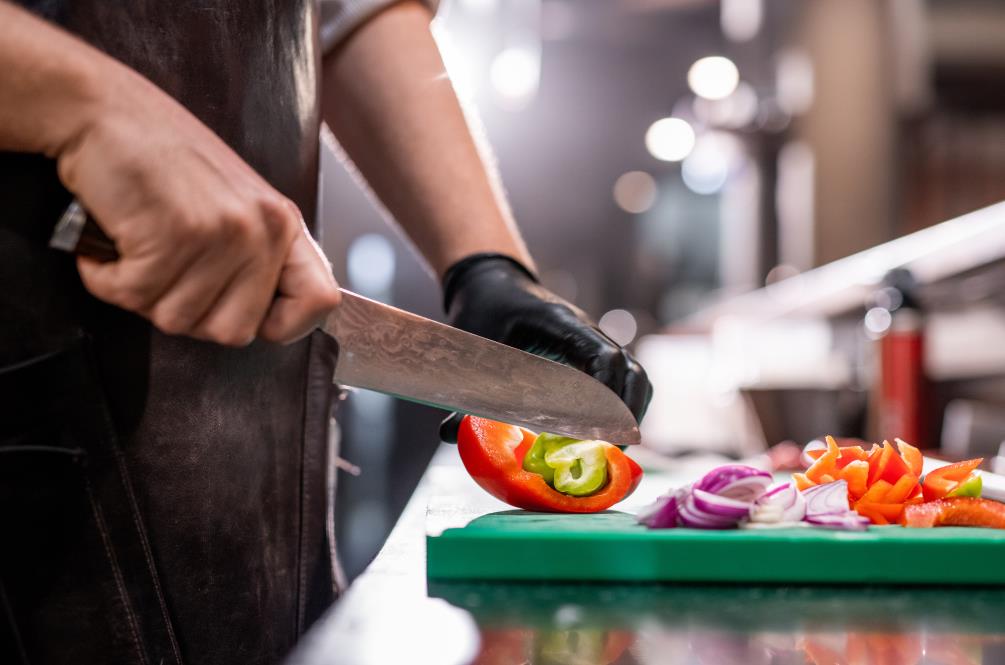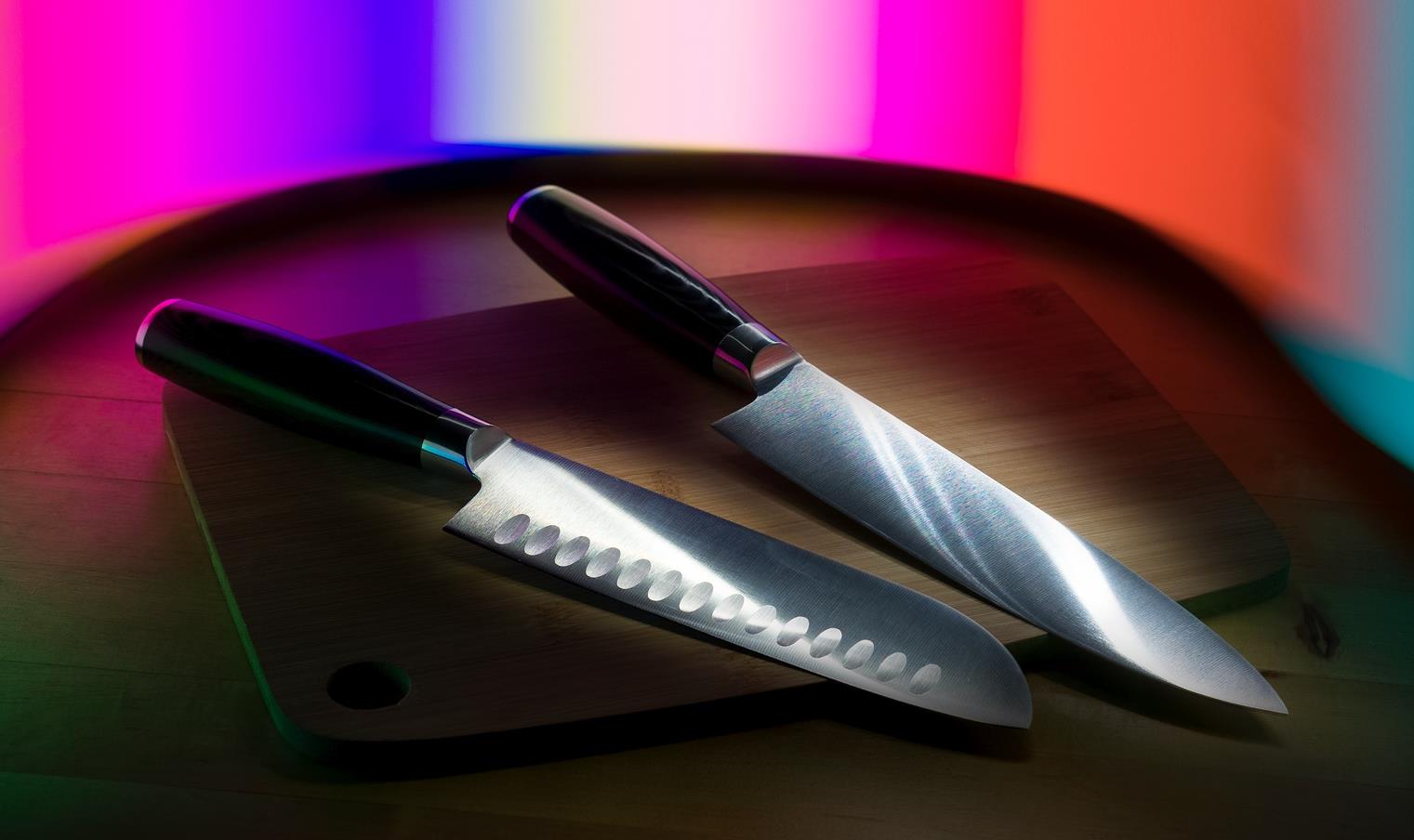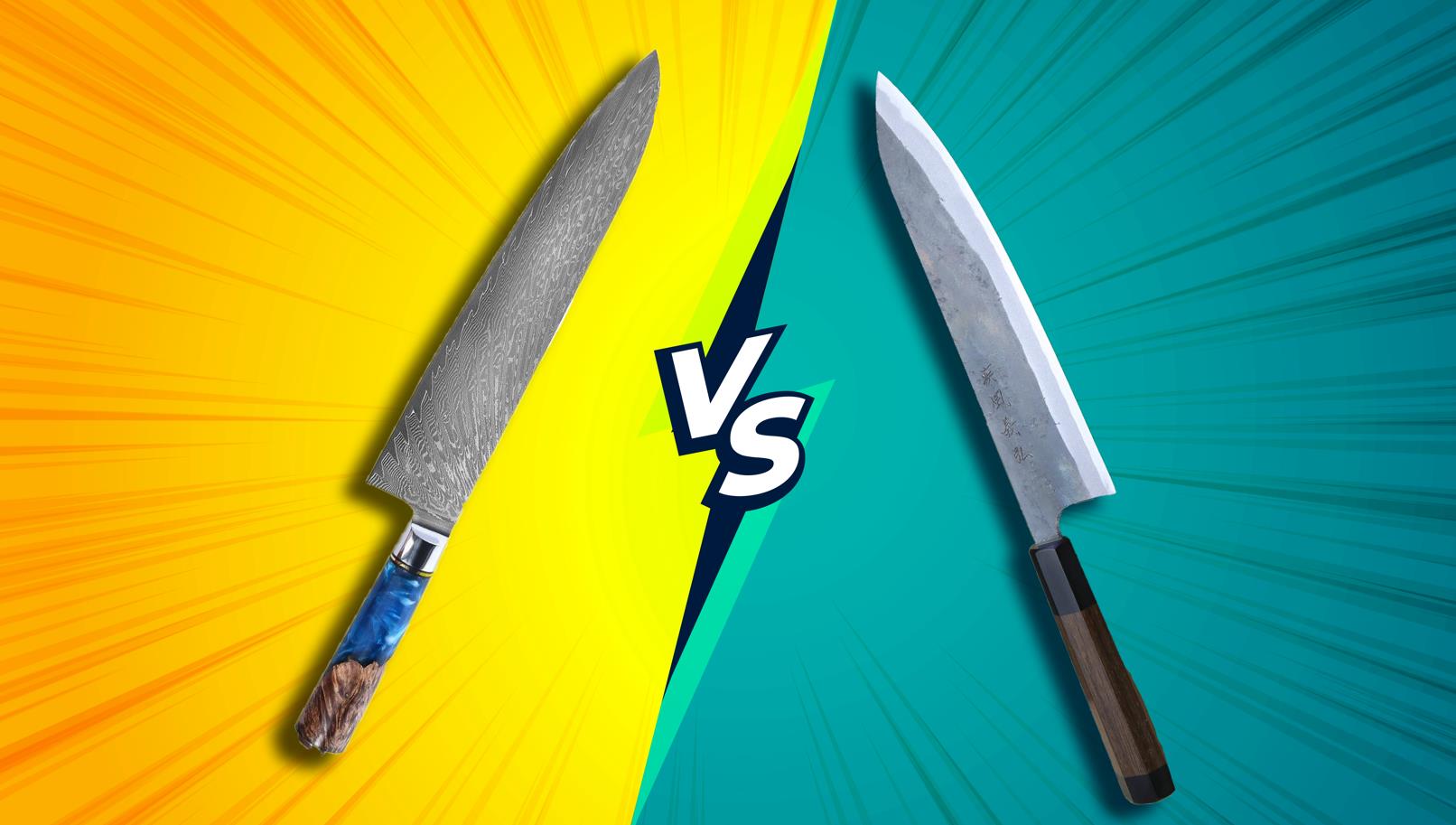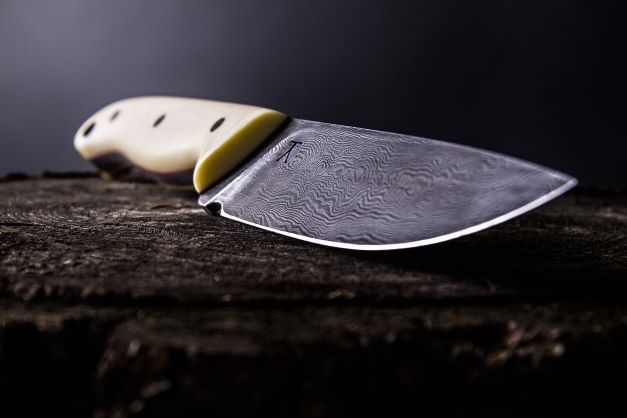Whether you’re an experienced chef looking to expand your blade collection, or a confused shopper looking for your first adult kitchen knife, you’ve come to the right place. Many buyers freeze when needing to decide on a knife’s materials, especially when they don’t understand how composition affects performance.
Two of the most popular kinds of knives are ones made of Damascus steel and ones high in carbon. Damascus sounds fancy, while carbon sounds reliable, so the best choice can sometimes elude us.
In a nutshell, the difference between Damascus steel and carbon steel lies in the manufacturing process, which also affects their appearance. Damascus steel is made by folding layers of steel and iron together, which translates into a unique, wavy design.
In turn, carbon steel is made by mixing iron with, you guessed it, hign carbon amount. For the material to be considered carbon steel, it must also contain limited alloying elements.
Both types satisfy different itches, so it’s important to not blindly throw yourself at one of the options. To help you choose, I’ve put together this guide to take the guesswork out of your decision.
Table of contents
What is Damascus steel?
Time for a short history lesson. Back when buying a sword meant you got to use it, rather than show it to your friends, Damascus steel blades were all the rage. They were imported from Southern India, Sri Lanka, or Iran and were highly sought after due to their hardness and flexibility.
Their name could come from the word “damas,” which means “water” in Arabic. Thus, Damascus referred to the wavy patterns that could be seen on the weapons. Apart from their intriguing looks, these swords became legendary for their resistance and sharp edge.
So, is Damascus steel strong? Well, Beowulf’s sword was said to be made out of traditional Damascus.
The ancient technique used to forge Damascus steel was lost for a long time. However, many have tried to reverse-engineer the process, and it was reproduced successfully not until the recent years.
Even though we now have the knowledge to recreate the ancient Damascus steel, the modern replications is not the same thing. The modern Damascus steel we can find in the market today is also called the pattern-welded steel.
Pattern-welded Damascus steel showcases some of the same impressive attributes. Knives made with it are very durable and can be honed into exceptionally sharp edges, which they retain longer than most other knives.

Pros
- Damascus blades are very strong and durable; they absorb shocks from impacts easily and preserve their quality for a really long time.
- Their edge is sharper than most other knives’ and they take a significantly longer time to become dull.
- Their appearance is unique, with no two blades sharing the same pattern. Of course, they are also very beautiful.
- They have an enticing historic flair, which also makes them elegant collector’s items.
Cons
- Some manufacturers don’t disclose the types of metal used to produce these knives, so you’ll need to stick with a reputable seller for optimal quality.
- Since they take longer to make, they usually come at a higher cost than other knives.
- They are not stain and corrosion-resistant, so they need to be cleaned and dried immediately after use.
- They are guaranteed to make your other knives envious.
What is carbon steel?
The technical definition of carbon steel requires the final result to have almost no additional alloys, making the primary two components carbon and iron.
Carbon is what gives them exceptional durability, so the higher the content, the stronger the blade. They last for very long periods of time, and some people believe them to be nearly indestructible. They also present great edge retention, as their hardness ensures they don’t wear out as quickly.
Carbon steel or Damascus steel, are comparably strong and reliable, but the former is easier to maintain. Their subdued appearance is perfect for people who don’t like the traditional models of the Damascus blades and prefer a more practical look.

Pros
- They are stronger and more durable than stainless steel knives, comparable to Damascus steel.
- They keep their edge sharp exceptionally well, even when cutting on metal or natural stone.
- Despite their hardness, they are easier to sharpen and hone than stainless steel knives.
Cons
- Depending on the amount of carbon, a carbon steel knife can be more brittle than stainless steel, which means it can chip more easily.
- They are susceptible to rust and corrosion, so they need to be manually cleaned and dried after each use (knives made with high chromium content are more resistant to rust)
- They can oxidize when cutting acidic foods, which sometimes ends in discoloration or stains.
Handpicked for you
True cutting power in the palm of your hand
Damascus steel vs carbon steel knives – comparison

It’s difficult to compare these two materials when talking about knives, especially since choosing a champion varies wildly depending on the way you intend to use them. A professional chef working in an open-kitchen restaurant has other needs than a home-based amateur.
Likewise, after you’ve passed a certain level of quality, it all comes down to personal preference. How does the knife feel in your hand? Does it make you want to cook something extravagant right now?
Of course, there are still a couple of factors you can consider when deciding, and keeping them in mind will help you choose a tool that’s perfect for your particular cooking style.
Durability
One of the most significant sell points for both types of knives is their exceptional durability. High-quality products will outlive you, granted you properly care for them. When assessing the durability of a certain knife, you must take its base materials into account.
Damascus knives are made by folding both tough and softer materials together. The hard layers give them their hardness, while the soft layers absorb shocks and impacts. The common type of steel used in Damascus knives includes:
- VG2 Steel (containing carbon, chromium, copper, and nickel)
- VG10 steel (containing carbon, chromium, cobalt, manganese, phosphorus, and vanadium)
In contrast, high carbon content knives also use a blend of hard and soft metals, but they sometimes end up being more brittle due to the manufacturing process. This means that they are easier to chip if dropped or when cutting on hard surfaces.
From a corrosion standpoint, they are both very pretentious. They are susceptible to rust and easy to stain when touching acidic foods like onions or tomatoes. However, due to the wavy pattern on the Damascus knives, they conceal stains better than carbon knives.
Performance
The competition between these two knives will make for a suspenseful Super Bowl Sunday when it comes to performance. Looking at a Damascus blade under a microscope, you’ll see abundant, precise serrations that resemble those on a scalpel razor.
Both knives can be sharpened and honed into superior sharp edges, that they both keep for very long times when properly cared for. High carbon knives are more wear-resistant due to the levels of carbides. This, in turn, steals from the blade’s flexibility and makes it more susceptible to chipping.
In turn, Damascus knives are more flexible, which makes for a better, more comfortable kitchen knife. However, the differences can only be seen when thoroughly comparing these two knives, side by side.
In a normal cooking environment, you will barely notice any discrepancies in performance between the two, granted they both use quality materials.
Maintenance
Maintenance is where we stray a bit from our draw. Damascus steel requires special care for it to retain its luster and original beauty. Although they retain their edge beautifully, inexperienced sharpeners can damage their fine edge.
They require sharpening with a whetstone, usually made out of ceramic or diamond, as power-operated sharpeners will lack the necessary precision. After cleaning and drying the knife, it should be lubricated with a special wax or mineral oil to protect it from moisture.
On the other hand, carbon knives are very easy to sharpen using any available tools. Manual sharpening is, of course, more precise, but it does not require a Ph.D., like in the case of Damascus blades.
Mineral oil can also protect it from moisture, but many people find it easier to skip this step as its appearance is not a big part of its appeal.
| Knives’ Super Bowl Sunday | Damascus Knives | Carbon Steel Knives |
| Durability | very durable, resistant to shocks, can be used on hard surfaces, susceptible to corrosion, rust, and stains | very durable, susceptible to chipping, corrosion, rust, and stains |
| Performance | incredibly sharp edge, keeps edge for longer, hard yet flexible | incredibly sharp edge, keeps edge for long, very hard yet not very flexible |
| Maintenance | requires very much care, is harder to sharpen, requires special tools, needs to be waxed or covered in mineral oil to prevent rusting and stains | very easy to care for, can be sharpened with any tool, does not require sharping experience, does not need waxing or oiling (although good to consider) |
| Cost | comes with a steep price tag | more expensive than normal kitchen knives, although cheaper than Damascus |
Which is better: a Damascus or carbon steel knife?

If you’re choosing between carbon steel or Damascus, you might be tempted to look for the slightest of differences. However, in most kitchens, these two knives behave pretty much the same.
They are both very strong, reliable tools that you’ll use for many years to come. Choosing between them is a matter of personal preference. How do these tools fit into your lifestyle? If you’re looking for a quality kitchen knife that won’t require much thought going forward, carbon steel is probably your best bet.
If you’d like to impress your friends and take some time out of your schedule to admire a masterpiece knife, you should go for Damascus. However, you should keep in mind that it requires more maintenance, as its beautiful, water-like patterns come at the cost of practicality.












